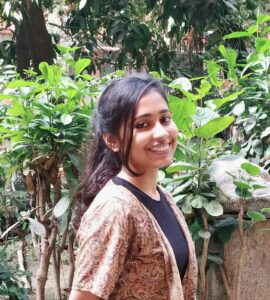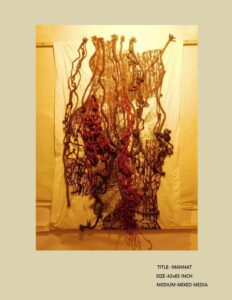“Hello, readers! Today, we’re exploring the stories of four individuals who once pursued art academically but have since found themselves working in various fields while still holding onto their love for creativity. They’re not claiming to be experts, and our conversation is all about keeping it light and enjoyable. Let’s jump right in and see where this journey takes us. Thanks for tuning in!”

Name: Jesmin khatun
Age: 26 years
“Devote so much time to your dream that being looked in the eye by you becomes someone else’s dream.”


Name: Puja koley
Age: 25 years
“Nothing is impossible if you want”


Name: Sujoy Naskar
Age: 26 years
“Nature will build you as you imagine”


Name: Riya Kundu
Age: 26 years
“Art is the only way to run away without leaving home.“

Q1. When did you first realize that you wanted to pursue art or continue on this path?
Sujoy: After 10th.
Riya: After 10th.
Jesmin: After 10th.
puja: After 10th.
Q2. How did you know that this was what you wanted to do or continue advancing in? How did you recognize the spark?
Sujoy: I used to enjoy it and felt peace while drawing, and it felt like the right way to express myself. I feel free, it came naturally.
Riya: Initially, I used to think that only painting is art, but later I came to know that not only painting but other things are also part of art. Then I chose textiles, so I had the desire beforehand, and after becoming aware, I felt that I could do it
Jesmin: After the 10th, I realized that I can study art, and I liked other designs such as logo design, so I decided to pursue them. I liked logo design and other designs, so I decided to pursue them.
puja: My simple reasoning was that I didn’t want to pursue general studies because finding a job would be difficult. Since I was good at drawing and had an interest in fashion, I pursued further studies in this field. Eventually, I shifted to textiles.
Q3. How much truth is there to the notion that those who study art aren’t good at academics or have lesser intellect?
Sujoy: There is no single definition of intellect; there are different fields, and we may not excel in all of them just as those individuals may not excel in our field.
Riya: We spend a lot of time in our own thoughts and contemplating about them, so people may think we are absent-minded, but that’s not true. However, yes, we do live in our own world.
Jesmin: Our way of thinking is different, so people may not find this way of thinking correct.
puja: This is a misconception because those who study art have a different way of thinking; they tend to delve deeper into things. Perhaps that’s why this perception exists, but it’s also wrong to think so.
Q4. Do you people hesitate to put a price on your artwork?
Sujoy: It depends. If working on someone else’s project, it’s a bit easier since there’s input from them. But when it’s your own artwork, it feels priceless.
Riya: When working on someone else’s demand, the price is usually determined beforehand based on resources and other factors. But when it’s your own work, most of the time, you don’t want to sell it.
Jesmin: It often feels very difficult, many times it seems like no matter how much money is offered, I just want to keep the artwork for myself.
puja: Yes, it takes a bit of consideration before setting the price.
Q5. Do you need to be a little crazy to be a real artist or really into art?
Sujoy: Yes, you definitely need a lot of passion! and some craziness.
Riya: Yes, absolutely. Actually, we’re not just artists anymore, we’ve become somewhat commercial. But those who remain involved in art forms are not just a little but very passionate and they become different from everyone else. So, my answer is yes!.
Jesmin: Every person has a bit of it within them. If they take their work very seriously, then it appears to others.
puja: I think yes, and I maintain a good work-life balance, which is why I never consider myself a fully committed artist.
Q6. Uncovering the Source of Inspiration: What drives artists to create, and where do they find their ideas?
Sujoy: I take inspiration from the problems of society or what I observe in daily life, but 90% of my work is based on what I’m feeling inside, and I paint what I’m experiencing emotionally.
Riya: My artwork is largely influenced by my mood, and I often find inspiration for new subjects to explore when I’m in a bad mood.
Jesmin: I usually follow what I see or what’s trending, and since I’m not an expert in painting, I simply follow what’s currently popular.
puja: My artwork is completely mood-driven; I’ve observed that when I’m in a good mood, my painting turns out fresh and vibrant. Additionally, I draw most of my inspiration from nature, as it closely relates to my artistic focus.
Q7. Help! I love to draw, but what’s next? How can a young artist like me explore their passion, build a creative career, and make a meaningful impact in the art world?
Sujoy: First and foremost, parents need to be aware because they are often the ones who create obstacles. They should know that there is a lot of scope in this field and they should also do their research so that they can provide the right support and guidance to their child, as the child already has the interest, they just need a guiding light.
Riya: In today’s digital age, social media reveals all – from college choices to exam prep. The key is to identify your true interests. While teachers may offer advice and impose boundaries, it’s essential to self-reflect and know what genuinely resonates with you. And for guidance, social media resources are readily available.
Jesmin: It’s essential to have a personal interest and for parents to be aware of the opportunities in this field. Moreover, it’s important to dispel the misconception that academic studies are not necessary once you pursue art. In reality, education and artistic pursuits can complement each other and lead to a well-rounded individual.
puja: Before pursuing anything, it’s essential to gain a deep understanding of oneself and acquire extensive knowledge. This will help you determine if you have a genuine interest, and only then should you proceed further.
Q8. The Rise of AI: Has it disrupted the art industry or opened up new creative avenues for artists to explore?
They all agreed that art and AI have no connection.
Q9. Can creativity thrive when motivated by money, or does it require a deeper love for the craft?
Sujoy: It’s all about pure passion, because thinking about money doesn’t create anything.
Riya: Yes! Earning money through art is very difficult. If you only focus on making money then there is a problem, you’ll keep working and enjoying your craft, and if money comes, it will come.
Jesmin: Follow passion.
puja: If financial gain is your primary concern, then a career in art may not be the best choice. There are numerous other fields and opportunities that offer more lucrative prospects, and you should consider those options.
Q10. Are you a good with managing your money ?
Sujoy: I don’t have that skill.
Riya: I really don’t know.
Jesmin: I just know that I shouldn’t waste money, that’s all. Nothing else.
puja: Not knowing enough!.
Q11. How do you perceive the concept of death?
Sujoy: My mindset is to keep drawing for as long as I’m alive. If I have 60 years on this earth, I’ll spend all 60 years creating art.
Riya: I’ve started thinking that I could die anytime, and I’ve also started writing a diary so that I can leave some notes behind for my loved ones.
Jesmin: Yes, I fear death, but before I die, I want to accomplish something so that people will remember me, saying ‘Jesmin achieved this’.
puja: I don’t worry about it at all. When my time is up, it’s up. There’s no point in dwelling on it.
———–Thank You———
–